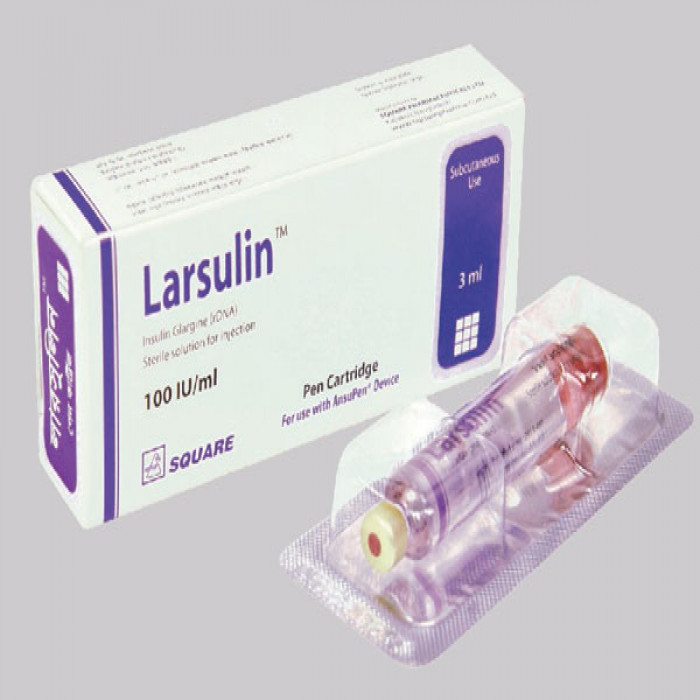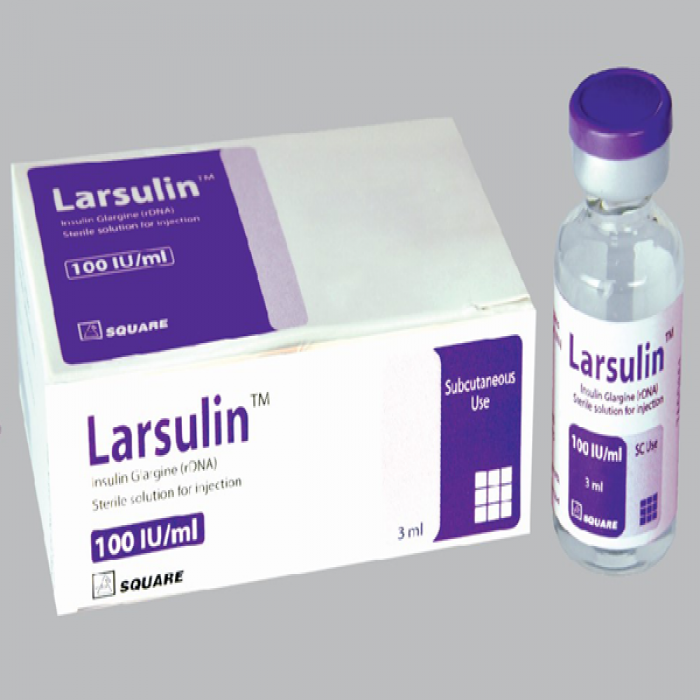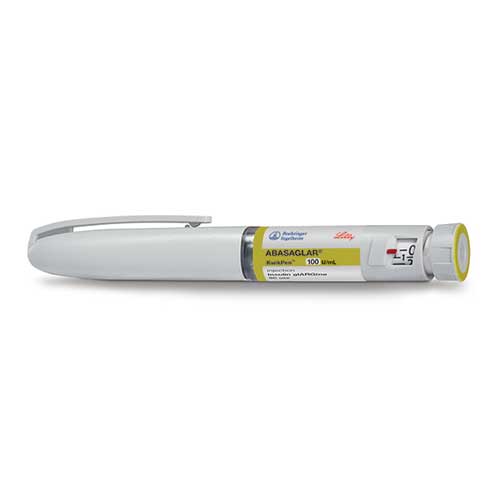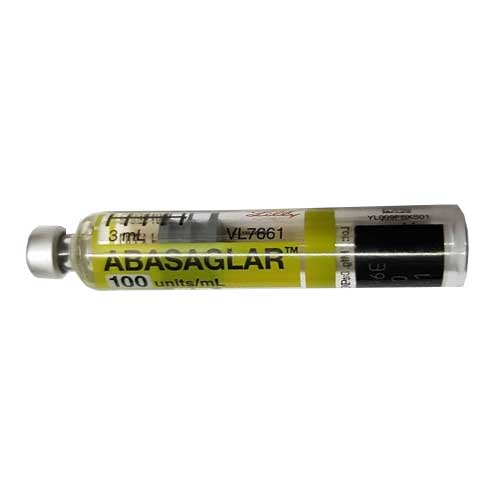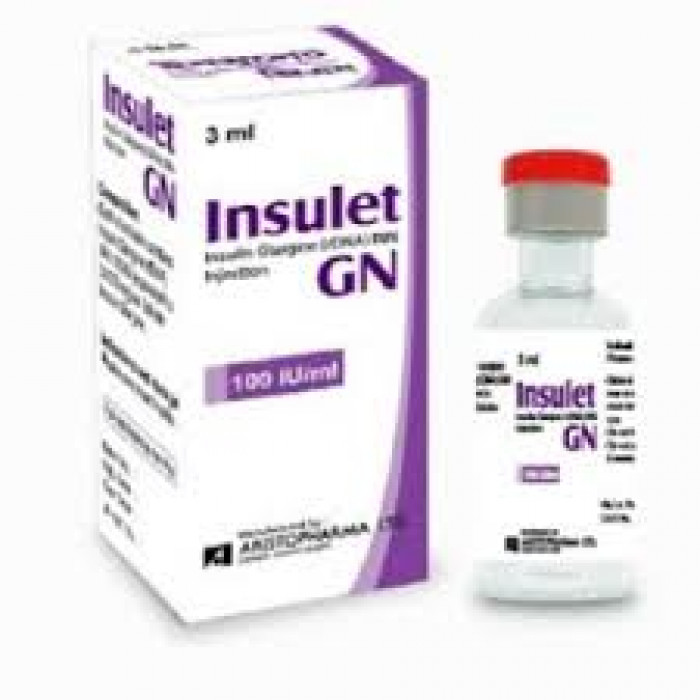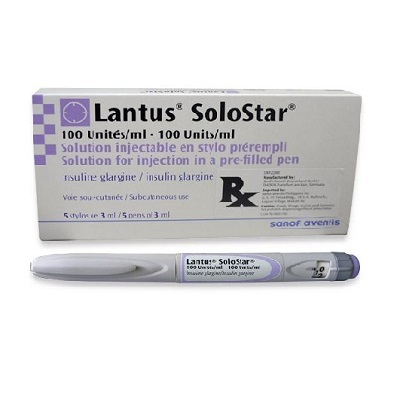
✔ 100% Authentic Product
👁️ Currently Viewing 8229
Lantus Insulin Cartridge 100IU/ml
Lantus Insulin Cartridge 100IU/ml is used to treat type 1 diabetes in adults and children, as well as type 2 diabetes in adults.
🚚 তাপমাত্রা নিয়ন্ত্রিত ডেলিভারি: এই পণ্যটি গুণগত মান বজায় রাখতে শুধু মাত্র ঢাকা শহরের ভিতরে আইস ব্যাগ এর মাধ্যমে ডেলিভারি করা হয়।
Discount
Price: ৳ 962
MRP:
৳
982
2%
Off

100% Genuine Products, Guaranteed

Safe & Secure Payments, Always

Fast, Secure & Efficient Delivery

Proper Packaging
 Cash on Delivery - All over Bangladesh
Cash on Delivery - All over Bangladesh Regular Delivery - 12-24 Hours, Dhaka City* Charge Tk.39-59
Regular Delivery - 12-24 Hours, Dhaka City* Charge Tk.39-59 Regular Delivery - 24-48 Hours, Other Cities* Charge Tk.99-110
Regular Delivery - 24-48 Hours, Other Cities* Charge Tk.99-110
 ফ্রি ডেলিভারিঃ - ৯৯৯ টাকা+ অর্ডারে, ঢাকা
শহরে
ফ্রি ডেলিভারিঃ - ৯৯৯ টাকা+ অর্ডারে, ঢাকা
শহরে ফ্রি ডেলিভারিঃ - ২৯৯৯ টাকা+ অর্ডারে, ঢাকার
বাহিরে
ফ্রি ডেলিভারিঃ - ২৯৯৯ টাকা+ অর্ডারে, ঢাকার
বাহিরে
100% Genuine Products, Guaranteed
Safe & Secure Payments, Always
Fast, Secure & Efficient Delivery
Proper Packaging
 Cash on Delivery - All over Bangladesh
Cash on Delivery - All over Bangladesh Regular Delivery - 12-24 Hours, Dhaka City* Charge Tk.39-59
Regular Delivery - 12-24 Hours, Dhaka City* Charge Tk.39-59 Regular Delivery - 24-48 Hours, Other Cities* Charge Tk.99-110
Regular Delivery - 24-48 Hours, Other Cities* Charge Tk.99-110 ফ্রি ডেলিভারিঃ - ৯৯৯ টাকা+ অর্ডারে, ঢাকা
শহরে
ফ্রি ডেলিভারিঃ - ৯৯৯ টাকা+ অর্ডারে, ঢাকা
শহরে ফ্রি ডেলিভারিঃ - ২৯৯৯ টাকা+ অর্ডারে, ঢাকার
বাহিরে
ফ্রি ডেলিভারিঃ - ২৯৯৯ টাকা+ অর্ডারে, ঢাকার
বাহিরে
✅ Description:
INSULIN GLARGINE is a modified, long-acting insulin akin to human insulin. It treats diabetes mellitus in individuals aged two and above, ensuring steady blood sugar control. Unlike short-acting insulins, it maintains consistent effects over 24 hours without peaks. This treatment prevents diabetes complications, excluding diabetic ketoacidosis.
INSULIN GLARGINE steadies blood sugar levels throughout the day, dosed based on tests, lifestyle, and prior insulin use. Injection site reactions like lumps or hypoglycemia symptoms, e.g., sweating, and anxiety, can occur but usually resolve naturally. Consult your doctor for persistent effects.
Avoid halting INSULIN GLARGINE without consulting your doctor, as it might cause withdrawal symptoms. It's not suitable for low blood glucose, kidney, liver, or heart issues, or with alcohol/recreational drugs. Combine it with a healthy diet, exercise, and weight maintenance as per your doctor's guidance.
Store INSULIN GLARGINE at 2-8°C in the fridge, not the freezer, as it's a cold chain medicine.
Safety Advices

Alcohol
UNSAFE
Avoid consumption of alcohol while receiving Lantus Insulin Cartridge 100IU/ml as it can raise or lower your blood sugar levels.

Pregnancy
CONSULT YOUR DOCTOR
If you are pregnant, think you may be pregnant or are planning to have a baby, ask your doctor for advice before receiving Lantus Insulin Cartridge 100IU/ml N. Careful control of your diabetes, particularly the prevention of hypoglycemia, is important for the health of the baby. The dose will be adjusted by your doctor.

Breastfeeding
CONSULT YOUR DOCTOR
Inform your doctor if you are breastfeeding before receiving Lantus Insulin Cartridge 100IU/ml as it is not known if it is excreted in breast milk. The dose and diet will be adjusted by your doctor.

Driving
CAUTION
Do not drive or use machines while receiving Lantus Insulin Cartridge 100IU/ml as your blood sugar can be low or high and your concentration and ability to react might be affected. Consult your doctor if you have frequent episodes of hypoglycemia.

Kidney
CONSULT YOUR DOCTOR
Lantus Insulin Cartridge 100IU/ml should be used with caution in patients with kidney disease. Your dose will be adjusted depending on your age, body weight, and disease condition. Consult your doctor before receiving Lantus Insulin Cartridge 100IU/ml.

Liver
CONSULT YOUR DOCTOR
Lantus Insulin Cartridge 100IU/ml should be used with caution in patients with liver disease. Your dose will be adjusted depending on your age, body weight, and disease condition. Consult your doctor before receiving it.
✔️ Uses of Lantus Insulin Cartridge 100IU/ml
Diabetes (Type 1 diabetes mellitus, Type 2 diabetes mellitus)
✔️ How does Lantus Insulin Cartridge 100IU/ml work?
Lantus Insulin Cartridge 100IU/ml is a long-acting insulin that offers consistent and continuous sugar control throughout the day. It mimics the action of your body's natural insulin, aiding in the uptake of sugar by muscles and fat cells while reducing sugar production in the liver.
✔️ Side Effects of Lantus Insulin Cartridge 100IU/ml
Hypoglycemia, allergic responses, injection site reaction, lipodystrophy, pruritus, and rash are all side effects of Insulin glargine.
✔️ Quick Suggestions:
- Exercise lowers insulin needs and may accelerate insulin effects, especially if near injection sites.
- Consult your doctor to adapt your insulin regimen for exercise.
- Avoid sugary foods, and opt for low-calorie cooked meals.
- When crossing time zones, discuss the insulin schedule with your doctor.
- Lantus 100IU/ml Solution: Inject daily at the same time, rotate injection sites.
- Exercise, diet, and other medicines are vital for diabetes management.
- Monitor blood sugar due to hypoglycemia risk.
- Carry high-sugar foods for hypoglycemia symptoms.
- Opened vials at room temp for 4 weeks, unopened in fridge.
- Insulin must be clear, colorless, and particle-free.
- Rotate injection sites to prevent skin issues.
✔️ Indication
Diabetes is a chronic condition that disrupts the body's ability to use insulin effectively, a hormone responsible for regulating blood sugar levels. Elevated blood glucose characterizes diabetes. There are two main types: type 1 and type 2 diabetes. Type 1 diabetes occurs when the pancreas produces insufficient or no insulin. Type 2 diabetes impacts sugar processing in the body. Symptoms include fatigue, frequent urination, excessive thirst, dry mouth, blurred vision, persistent hunger, weight loss, and itchy skin. Diabetes management involves monitoring blood sugar levels and adopting lifestyle changes.
✔️ Pharmacology
Insulin Glargine is a sterile insulin glargine solution intended for subcutaneous injection. Insulin glargine is a long-acting (up to the 24-hour duration of action) parenteral blood glucose-lowering medication made from recombinant human insulin analogs. Recombinant DNA technology is used to make Insulin Glargine. Insulin glargine's primary role is to regulate glucose metabolism. Insulin and its analogs reduce blood glucose levels by stimulating peripheral glucose absorption, especially in skeletal muscle and fat, and decreasing hepatic glucose synthesis. Insulin promotes protein synthesis while inhibiting lipolysis and proteolysis.
✔️ Dosage & Administration of Lantus Insulin Cartridge 100IU/ml
Insulin Glargine maintains a consistent glucose-lowering effect for 24 hours, allowing for once-daily dosing. Its potency is similar to human insulin. Administered subcutaneously once daily, it can be taken at any time but should be consistent. The dosage is tailored to each patient's response, and blood glucose monitoring is vital. For type 1 diabetes, the use of short-acting insulin is recommended. Avoid intravenous administration due to potential severe hypoglycemia.
Starting Insulin Glargine:
- Type 1 diabetes, begin with about one-third of daily insulin requirements, using short-acting insulin for the rest.
- In type 2 diabetes without insulin treatment, start with 10 units (or 0.2 Units/kg) once daily, adjusting as needed.
Switching to Insulin Glargine:
- Adjust shorter-acting insulins and oral antidiabetic doses when changing from other insulins.
- The transition from once-daily NPH insulin to Insulin Glargine with the same dose.
- For twice-daily NPH insulin to Insulin Glargine, start with 80% of the total NPH dose.
To use the cartridge:
- Insert the cartridge and needle, and gently mix by turning the pen upside down.
- Adjust the dosage button and prepare the needle without touching it to anything.
Injection site:
- Choose a less tight skin area like the arm, thigh, buttock, and abdomen.
- Keep at least a 1 cm distance from previous injection sites.
Injection method:
- Cleanse skin with alcohol.
- Insert the needle at a 45° angle.
- Inject insulin and keep the needle in for 6 seconds.
- Remove the needle, apply gentle pressure, and avoid rubbing the site.
✔️ Interaction
A variety of medications have an effect on glucose metabolism and may necessitate dosage adjustments.
Insulin and Insulin glargine needs may be reduced by the following substances: Angiotensin-converting enzyme (ACE) inhibitors, disopyramide, fibrates, fluoxetine, monoamine oxidase inhibitors, propoxyphene, pentoxifylline, salicylates, and sulfonamide antibiotics are all examples of oral anti-diabetic medications.
Insulin and Insulin glargine needs may be increased by the following substances: Thiazides, glucocorticoids, thyroid hormones, beta-sympathomimetics, growth hormone, and danazol are some of the medications used to treat these conditions. Beta-blockers, clonidine, lithium salts, and alcohol may enhance or diminish insulin's blood-glucose-lowering impact.
✔️ Contraindications
In patients who are hypersensitive to insulin glargine or any of its excipients, insulin glargine is not recommended.
✔️ Pregnancy & Lactation
Category C pregnancy. During pregnancy, insulin glargine should only be administered if the possible benefit outweighs the danger to the fetus.
It is unknown whether insulin glargine is secreted in human milk during lactation. Because many medications, including human insulin, are excreted in human milk, Insulin glargine should be provided with caution to a breastfeeding mother. Insulin dosage and nutrition may need to be adjusted for lactating women.
✔️ Precautions & Warnings
Dose adjustment and monitoring: All insulin-treated individuals should have their blood glucose levels checked on a regular basis. Insulin regimens should only be changed with caution and under the guidance of a doctor.
Insulin glargine should never be blended or diluted with any other insulin or solution. Because severe hypoglycemia can occur when given subcutaneously via an insulin pump or intravenously, it is not recommended.
Renal or hepatic impairment: In these circumstances, lowering the Insulin glargine dose may be necessary.
✔️ Storage Conditions
Store at 2° C to 8° C in a refrigerator. Do not freeze. In the case of insulin for recent use need not be refrigerated, try to keep it in a cool place and keep it away from heat and light. The insulin in use can be kept at room temperature for a month.
⚠️Disclaimer:
At ePharma, we’re committed to providing accurate and accessible health information. However, all content is intended for informational purposes only and should not replace medical advice from a qualified physician. Please consult your healthcare provider for personalized guidance. We aim to support, not substitute, the doctor-patient relationship.




